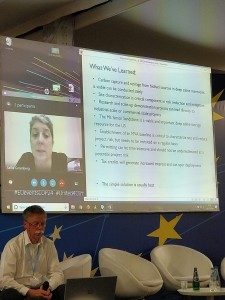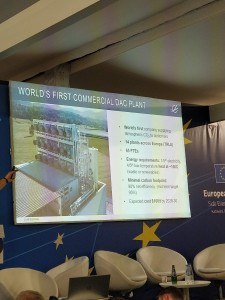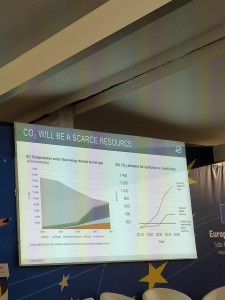Yesterday, I went to an event on demystifying carbon capture technologies. They are here, but are they here to stay?
Sallie Greenberg, a geologist at the Illinois State Geological Survey talking about experiments they have conducted in Illinois to inject CO2 into saline aquifers. Her team has shown that it is a proven method that could be scaled up to provide storage of CO2 out of the atmosphere. There are obvious challenges with sighting and injecting but she believes this can contribute to fighting climate change.
The co-founder of the world’s first commercially available carbon capture technology gave a presentation about how his team’s product has a net 90% efficiency in pulling carbon directly out of the air. It pulls out carbon and liquifies it. Water is also a byproduct of the process. It has been rolled out across several European countries.
This is a scheme of how the first negative carbon plant in Iceland works. Its hooked up to a geothermal plant to provide the heat necessary to remove carbon. The chemistry to me is not clear but this seems promising.
The founder did recognize that this is not the solution to climate change. In fact, he stated that trees and nature-based solutions a better option. However, he cited that with the decline of the use of petroleum products, the world will still need a carbon source for industrial products.
What do you guys think about carbon capture? Will it be necessary if we overshoot the 1.5 mark?




I also think it would be better to leave the work to the trees. In my opinion you should leave the work to nature. They were made to do something and I don’t think you should take it away from them.-Madison Media Providence Friends School
Hi Madison, I’m a big fan of trees for carbon capture, too. The only trouble is that in their special report on limiting global heating to 1.5C, the Intergovernmental Panel on Climate Change was very clear that we won’t manage to stay at 1.5 without significant carbon reduction. Some scientists think we can’t manage the necessary amount of carbon reduction just with trees (partly because humans keep cutting trees down in order to produce more food for our growing population). I would push for agro-forestry–trying to get better at supporting forests and finding food for humans–but I recognize that this may not be enough of a solution. I don’t hear anyone here talking about growing kelp farms in the ocean: that would be one way of producing food while also removing carbon from the ocean (which is also really important, because the ocean is absorbing a LOT of carbon dioxide and as a result, it is becoming more acidic, with the result that traditional kinds of food we’ve gotten from the ocean–fish, shellfish–may diminish in numbers). But let’s assume we agree it’s worth researching whether or not we can remove carbon from the atmosphere through a technological/industrial method: what do we do with it then? There was a headline in the Guardian newspaper Monday about the biosphere under the earth’s surface: what do we do to the living creatures underground if/when we start injecting carbon below the earth’s surface? (See https://www.theguardian.com/science/2018/dec/10/tread-softly-because-you-tread-on-23bn-tonnes-of-micro-organisms.) What do we do to geological stability? (Fracking gas has increased the likelihood of earthquakes in many parts of the world where this practice is used.) So many questions, right?
C capture is becoming more viable and there are lots of new advances that are being the technology closer to practical realizations. An important aspect though is where do you put the CO2 once it is captured, and this is a nontrivial issue.
Chris, I think the last presentation Saadiq described suggested using the carbon to create plastics (which of course has other issues, too). What do you think we should be doing with captured carbon?